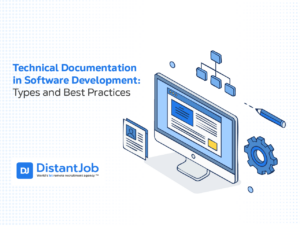Collaboration tools can make or break your project’s success. As technology evolves, so do developers’ needs and the platforms they use to collaborate. This article examines the best collaboration tools for developers in 2025.
Each one was selected to surpass basic communication and offer comprehensive, adaptable solutions for diverse development workflows. Whether you’re managing a remote team or a co-located one, these tools can streamline everything from version control to project management, helping you create a more cohesive and productive work environment.
The best collaboration tools for developers should prioritize comprehensive functionality over simplicity, offering full-featured platforms that can adapt to different project needs rather than limited single-purpose tools. When choosing between dozens of available options, focus on platforms that provide comprehensive toolkits, allowing you to customize workflows for various development projects.
That said, these tools are simple enough and suited to a wide range of applications, including version control, project management, real-time collaboration, code sharing, and more
- GitHub – Best used for version control, code hosting, and project management.
- BitBucket – Best used for integrated CI/CD and Jira integration.
- GitLab – Best used for security DevSecOps practices.
- Azure DevOps – Best used for DevOps, Azure, and Microsoft integration
- Codeanywhere – Best used for collaboration in a cloud-based coding environment
- Jira – Best used for Agile development teams
- Visual Studio Live Share – Best used for robust code collaboration tools.
- Codepen – Best used for front-end development.
- Slack – Best used for effective asynchronous communication in any work environment.
Top 9 Best Collaboration Tools for Developers
Here is an in-depth analysis and overview of the best software development collaboration tools, including their pros and cons, features, pricing, and best use cases to help you choose the right platform for your development team.
1. GitHub

GitHub is a vital platform for developers because it serves as a central hub for hosting and collaborating on Git repositories. It’s built on top of Git, which is a version control system that tracks changes to code, allows multiple people to work on the same project without conflict, and enables easy reversion to previous versions.
GitHub provides social features that have made it the industry standard for open-source projects. Features like pull requests and issue management streamline collaboration and bug tracking. For individual developers, GitHub also acts as a public portfolio, showcasing their skills and projects to potential employers.
GitHub Pros
- GitHub promotes teamwork, enabling the timely execution of large projects with fewer errors.
- It streamlines the overall development process.
- Enhances code quality and integrity by facilitating real-time feedback and collaboration, reducing errors, and improving the codebase.
- Offers robust security features and increased safety with packages for secure coding.
- Features a large community and detailed documentation, which are highly beneficial for developers.
- Allows multiple individuals to work on the same code, both online and offline.
GitHub Cons
- Complexity: GitHub might be complex for beginners to navigate.
- Pricing: Advanced features need a paid plan.
- Limitations: 500MB storage limits (free tier) and limited offline access.
- Security Concerns: Some users may have security concerns about trusting GitHub’s cloud with high-value intellectual property, especially due to Copilot.
- Learning Curve: Has a learning curve for those unfamiliar with containerized development (for GitHub Codespaces).
Pricing and Plans
GitHub offers various pricing tiers:
- Free Plan: Available for open-source projects in public and private repositories and includes unlimited public repositories.
- Team Plan: Starts from $4 per user per month (billed annually), or $44 per user per year for the first 12 months.
- Enterprise Plan: Priced at $21 per user per year for the first 12 months, offering the most features.
GitHub Best Use Cases
GitHub is consistently chosen and recommended for:
- AI-powered code assistance through GitHub Copilot enhances the coding experience by integrating AI into the development workflow.
- GitHub Codespaces provides on-demand development environments, streamlining setup and offering efficient, direct integration into the GitHub ecosystem.
- Essential for code collaboration and version control. From the most beginner junior to the most experienced senior developer, everyone should learn Git and GitHub
- Helpful to track changes and ensure seamless collaboration on code development and integration.
2. BitBucket
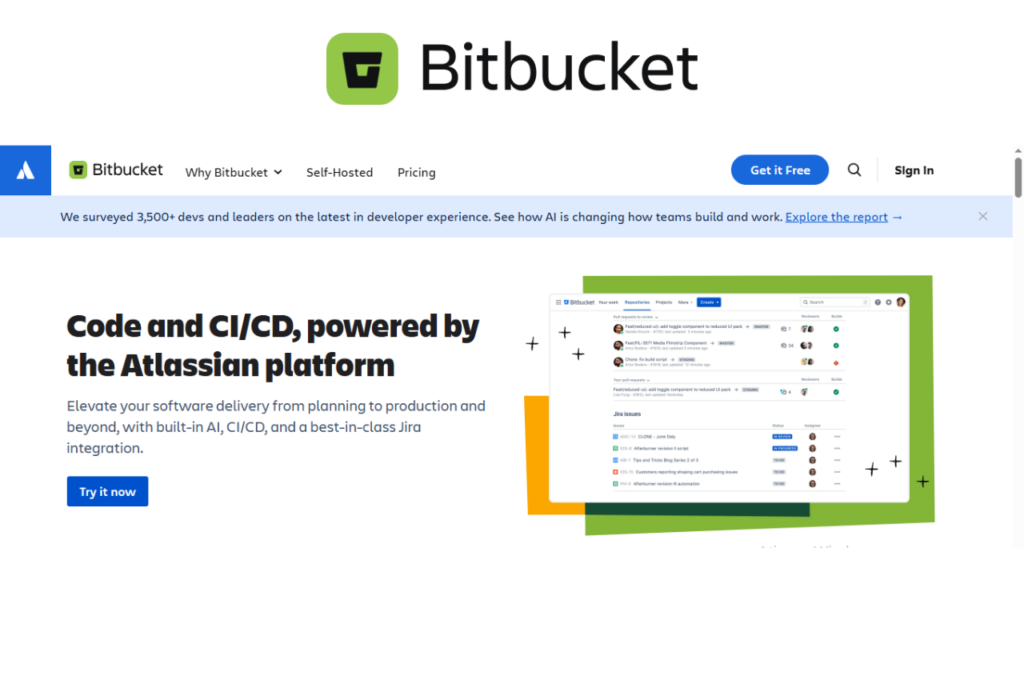
Bitbucket is a code repository platform that integrates well with other Atlassian products like Jira and Confluence for workflow integration. The platform has built-in CI/CD pipeline capabilities (Bitbucket Pipelines), and may choose it for its past offering of free private repositories. Bitbucket’s integration with Azure and a focus on enterprise/business users over open-source communities make it a solid choice for your company project.
BitBucket Pros
- Seamless Integration with Atlassian Tools: Bitbucket offers robust integrations with other Atlassian products, such as Jira and Confluence, and with Microsoft Azure as well. This strong integration allows for direct linking of code changes to Jira issues, enhancing traceability and improving communication between development and project management teams.
- Integrated CI/CD: Its tight-knit integration of Git repositories with CI/CD operations makes it a standout choice for streamlined development workflows.
- Strong Collaboration Tools: It provides powerful tools for sharing code and fostering team collaboration.
- High-Level Security: Bitbucket boasts high-level security features and access controls.
- Video Calls: The ability to hold video calls directly within the platform strengthens its collaborative environment.
BitBucket Cons
- Complexity for Beginners: The user interface might appear complex for beginners. It can also have a steep learning curve, especially for those new to Git.
- Reliance on Atlassian Ecosystem: Integration with non-Atlassian tools can sometimes be less intuitive.
- Limitations on Free Plan: Larger teams might experience limitations on the free plan. The free plan also has limited free CI/CD minutes.
- Cost for Advanced Features: Some really advanced options will require a paid plan, making it potentially costly for larger teams or advanced functions.
- Setup Complexity: It can be quite complex to set up, especially for new users.
BitBucket Pricing
Bitbucket offers a free plan. For more features, it has paid tiers, with pricing starting from $3.30 per user per month.
BitBucket Best Use Cases
Bitbucket is primarily chosen and recommended for:
- Integrated CI/CD with Git repositories.
- Robust and unparalleled integration with Jira.
- Ideal for teams already using Jira who need extensive features for software development collaboration.
- Capability to streamline workflows and improve communication between development and project management teams.
3. GitLab

GitLab provides version control, code collaboration, and built-in continuous integration and deployment (CI/CD) pipelines, integrating security DevSecOps practices throughout the software development lifecycle.
As a web-based platform, GitLab offers a comprehensive suite of tools designed to cover the full DevOps lifecycle. It functions as a Git repository manager with various features, including wikis, issue tracking, and Continuous Integration/Continuous Deployment (CI/CD) pipelines.
GitLab’s primary goal is to provide a platform for software developers to collaborate on code and manage it throughout its lifecycle. Here’s a detailed look at GitLab:
GitLab Pros
- All-in-one Solution: GitLab offers a holistic approach to software development and deployment by providing a comprehensive suite of tools. This makes it a robust and powerful platform.
- Extensive Integrations: It plays well with a myriad of third-party tools, enhancing its versatility.
- Built-in Security: Its comprehensive DevSecOps approach means security is integrated into every stage of the development lifecycle.
- DevOps Focus: It particularly emphasizes features appropriate for the DevOps approach, facilitating collaboration between development and operations teams for faster project completion.
GitLab Cons
- Cost: GitLab is generally more expensive than its main competitor, GitHub. Some advanced features are restricted to higher pricing tiers.
- Complexity/Learning Curve: There are many features. This might be overwhelming for newcomers, and it can have a higher learning curve.
- Performance Variability: The platform’s performance might vary depending on the deployment choice (self-hosted vs. cloud).
- Search Functionality Limitations: There may be limitations in its search functionality.
- Complex Setup: Setting up GitLab can be complex.
GitLab Pricing
GitLab offers several pricing tiers:
- Free plan: Available.
- Premium plan: Starts from $19/user/month.
- Ultimate plan: Available.
- It also provides a 30-day free trial and a free demo.
GitLab Best Use Cases
GitLab is consistently recommended for comprehensive DevSecOps and teams in need of an all-in-one DevOps toolchain. It is essential for code collaboration and version control.
4. Azure DevOps
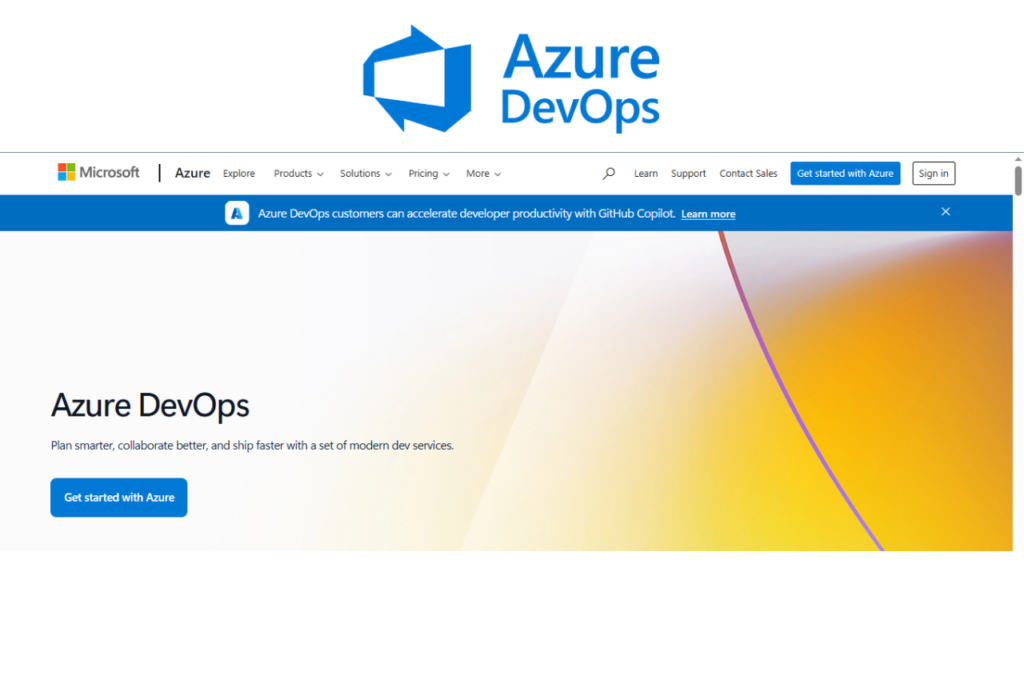
Azure DevOps offers an end-to-end Application Lifecycle Management (ALM) platform. It features project management with granular control (boards, backlogs, sprints), version control (Azure Repos), continuous integration/continuous delivery (CI/CD) pipelines (Azure Pipelines), automated testing, and artifact management (Azure Artifacts).
Azure DevOps integrates seamlessly with the Azure Cloud.
Azure DevOps Pros
- Strong Microsoft Integration: Seamlessly integrates with other Microsoft products and services like Azure cloud and Active Directory, creating a cohesive environment for Microsoft-centric development.
- Comprehensive Toolset: Offers a wide array of tools for project planning, code management, CI/CD pipelines, and testing, catering to various development needs.
- Granular Control: Azure DevOps provides fine-grained permission sets, workflow management, and ticket creation.
- Scalability: Designed to handle projects of any size, from small teams to large enterprises.
- Security: Leverages Azure Active Directory for robust security and access control.
- Flexibility: Supports a wide range of programming languages, frameworks, and deployment targets.
- Version Control: Includes Azure Repos, a Git-based version control system, for efficient code management and collaboration.
Azure DevOps Cons
- Learning Curve: The platform can be complex and require time for teams to learn and effectively utilize its features, especially for those new to the Microsoft ecosystem.
- Integration Limitations: While it integrates well with Microsoft products, its integrations with cloud-native technologies and non-Microsoft tools may not be as robust or seamless as desired.
- Interface Complexity: The user interface can feel overwhelming and inconsistent, with different services having distinct navigation patterns.
- Customization Limits: While it offers customization options, they might not be as extensive as some competitors, particularly in reporting and dashboarding.
- Potential Vendor Lock-in: Reliance on Azure DevOps can lead to increased dependency on the Microsoft ecosystem.
Azure DevOps Pricing
The pricing information from the Azure website is not very clear, but here is a simplified explanation of the pricing for Azure DevOps Services.
Free Tier:
- Users: The first five users get access to the Basic plan for free.
- Pipelines: You get one free Microsoft-hosted CI/CD job (with 1,800 minutes per month) and one free self-hosted job (with unlimited minutes).
- Artifacts: The first 2 GiB of storage are free.
Paid Options:
- Additional Users: After the first five free users, each additional user costs $6 per month.
- Basic + Test Plans: This plan costs $52 per user per month and includes all the features of the Basic plan plus additional testing tools.
- Visual Studio Subscribers: If you have a Visual Studio subscription, you get free access to Azure DevOps, and you don’t count towards the five free users.
- Pipelines: Additional Microsoft-hosted jobs are $40 each per month, and additional self-hosted jobs are $15 each per month.
- Artifacts: If you need more storage, it is available on a tiered basis, starting at $2 per GiB.
- GitHub Advanced Security for Azure DevOps:
- Code Security: $30 per committer per month.
- Secret Protection: $19 per committer per month.
5. Codeanywhere

Codeanywhere is a versatile cloud-based coding environment and collaborative coding tool that allows developers to write and manage code from virtually any device. Its primary strength lies in enabling location-independent coding, making it suitable for developers who need flexible access to their codebase.
Codeanywhere Pros
- Strong Integrations: It integrates well with major code repositories (GitHub, GitLab, Bitbucket).
- Easy Environment Configuration: The tool allows for easy configuration of development environments.
- Real-time Cursor Sharing: This feature promotes effective collaboration by showing real-time activity within the code.
Codeanywhere Cons
- Limited Offline Capabilities: Its functionality might be restricted without an internet connection.
- Mobile App Limitations: The experience on its mobile application can be limiting.
- Learning Curve: Users new to cloud-based platforms might face a learning curve when adopting Codeanywhere.
Code Anywhere Pricing
Codeanywhere offers a free trial available for users to test its capabilities. For continued or advanced use, its pricing starts from $9.60 per user per month (billed annually).
Codeanywhere Best Use Cases
Codeanywhere is recognized as the “Best for cloud-based coding from any device”. It is designed to provide an intuitive environment for developers to access and contribute to a codebase regardless of their physical location or the device they are using.
6. Jira
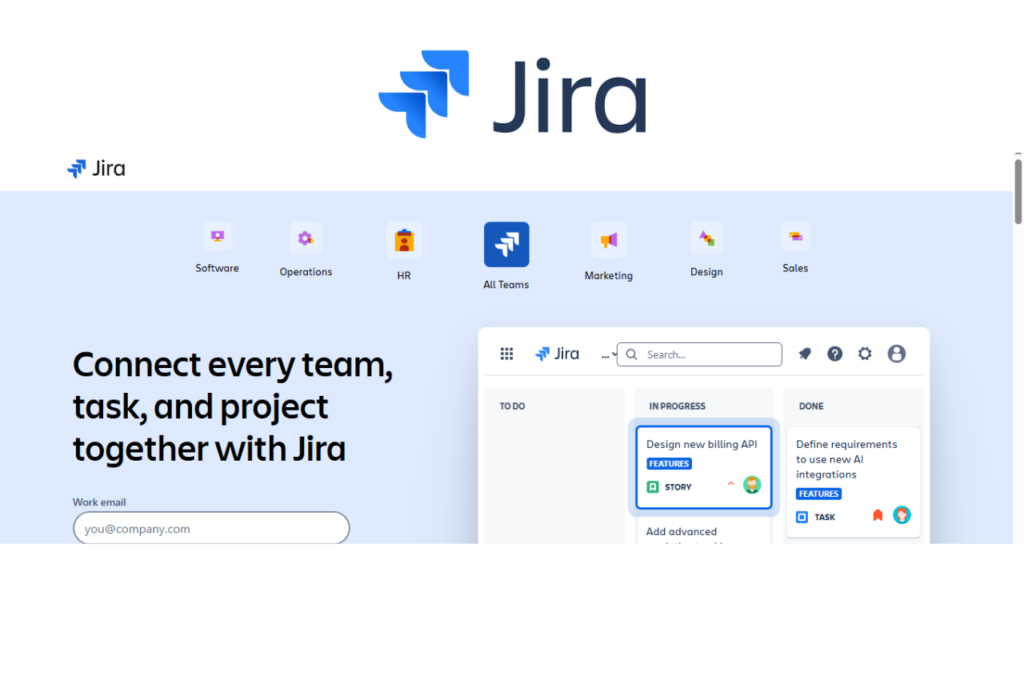
Jira’s power, flexibility for complex projects, and strong integration capabilities are tailored for agile workflows. It’s highly effective for agile development, offering issue tracking, sprint planning, customizable workflows, and detailed reporting. Developed by Atlassian, it is a widely recognized application for project management, particularly for agile development teams. It is highly valued for its ability to track bugs, plan sprints, and manage agile projects effectively.
Jira Pros
- Atlassian Ecosystem Integration: Jira offers robust and seamless integrations with other Atlassian products, including Confluence (for documentation), Bitbucket (code repository and version control), and Trello (Kanban boards).
- Scalability: It is appropriate for both small teams and large organizations.
- Customization: Workflows and fields are customizable to a great extent.
- Developer-Friendly: It helps teams break down long-term plans into individual tasks.
- Centralized Information: Integrations allow for receiving project updates directly in communication channels, centralizing information and reducing context switching.
Jira Cons
- Learning Curve: Jira can be hard to learn for new users due to its advanced features and comprehensive nature.
- Cost: It tends to be costly for large teams and companies, with advanced features requiring paid plans.
- Report Download Limitations: Reports are only available directly in Jira and cannot be downloaded.
- Complexity with Large Teams: It can become quite expensive when working with larger teams.
Jira Pricing
Jira offers several pricing tiers:
- Free plan: Available for up to 10 users.
- Standard plan: Starts at $7.53 per user per month.
- Premium plan: Priced at $15.25 per user per month, or $14.50 per month.
- Enterprise plan: Available for larger organizations (e.g., more than 800 users), pricing upon contact with sales.
Jira Best Use Cases
For agile project management, issue tracking, and bug reporting, Jira is a consistent choice. It is ideal for teams that follow Agile methodologies like Scrum and Kanban and need a tool to plan, track, and deliver software projects. Integration with other Atlassian tools makes it particularly strong for teams already embedded in that ecosystem.
7. Visual Studio Live Share
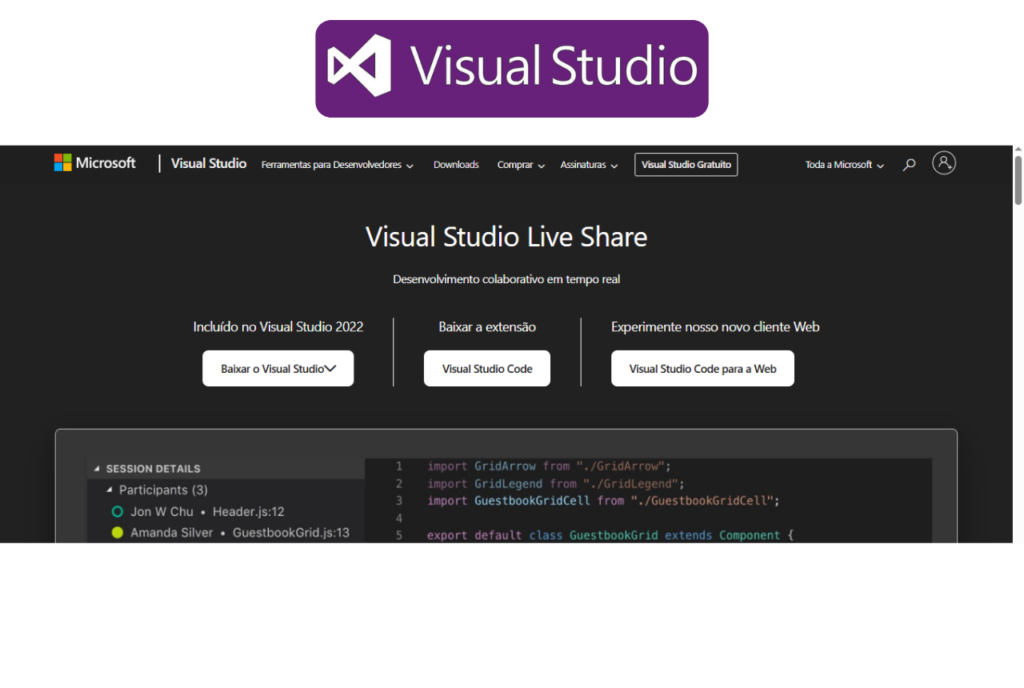
Visual Studio Live Share provides features like shared cursors and co-editing, allowing developers to cooperate on programming in real-time, similarly to Google Docs for code. This VS Code extension is a real-time code collaboration tool that allows developers to co-edit and debug code simultaneously in real-time. It is an essential component for real-time collaborative coding.
Visual Studio Live Code Pros
- Improved Productivity: Tools like Visual Studio Code Live Share help improve productivity by streamlining workflows and reducing context switching, as developers can perform most tasks within a single environment.
- Enhanced Code Quality: Built-in collaboration tools like Live Share contribute to maintaining high code quality through features such as code reviews, debugging, and testing, which accelerate the development process.
- Integration: As part of the GitHub ecosystem, GitHub Codespaces provides a fully-featured Visual Studio Code environment accessible from any device or browser, with native compatibility to GitHub repositories and actions, and direct integration with Visual Studio Code extensions.
- Simultaneous Editing: Teams can work on the same codebase concurrently, enhancing productivity.
- Shared Debugging Sessions: Developers can participate in shared debugging sessions to resolve issues together.
- Terminal Sharing: The tool supports terminal sharing, which can be useful for collaborative troubleshooting and execution.
- Flexible Permissions: It offers flexible permissions, allowing teams to control access and contributions.
Visual Studio Live Share Cons
- Dependency on Trust: Sharing full access to your environment requires a high level of trust, as collaborators can potentially execute commands or access sensitive information.
- Connectivity Requirements: Relies on a stable internet connection for effective real-time collaboration, and proxy configurations can sometimes present challenges.
- Limited Beyond Code: Primarily focused on code collaboration and does not directly facilitate broader aspects of project management, such as discussing requirements or reviewing non-code artifacts.
- Potential for Performance Issues: Large projects or slow internet connections can sometimes lead to latency or performance degradation during collaborative sessions.
- Security Considerations: While encrypted, the transmission of code and debugging information over the internet necessitates awareness of potential security risks when collaborating with external or untrusted parties.
Visual Studio Live Share Pricing
It’s free.
Visual Studio Live Share Best Use Cases
Live Share facilitates seamless pair or mob programming. It allows multiple developers to simultaneously edit, debug, and navigate the same codebase. This fosters shared understanding, knowledge transfer, and immediate feedback. In time-sensitive collaborative environments, like hackathons, Live Share can significantly enhance team productivity by enabling real-time code sharing and synchronized progress tracking.
8. Codepen

CodePen is an interactive coding environment and collaboration tool primarily designed for frontend developers. It acts as a dynamic code editor tailored for team projects, serving as a “hotspot for showcasing and testing HTML, CSS, and JavaScript snippets”. Codepen is one of the best tools for frontend design and development playgrounds.
Codepen Pros
- Ease of Use: The interface is straightforward to learn, making it an excellent tool for beginners to practice and experiment with front-end code.
- Community & Collaboration: CodePen boasts a large and active community, facilitating collaboration, skill development through themed challenges, and inspiration from other developers’ work.
- Prototyping & Snippet Showcase: It’s an ideal platform for quickly testing new ideas, building prototypes, and sharing individual code snippets or small projects publicly.
- Portfolio & Learning: CodePen is great for building a personal portfolio of projects, practicing new languages, and discovering new code and techniques.
- Free Access: Generous free plans are available, allowing users to get started without any cost.
Cons of Codepen
- Performance Limitations: Heavy or complex code can lead to lag and a less responsive experience, as the platform is primarily designed for smaller snippets.
- Limited for Large Projects: It’s not the best environment for managing larger projects or applications, as it lacks features found in more comprehensive IDEs.
- User Interface & Screen Size: The interface can take up a lot of screen real estate, and the platform’s layout is not always ideal for smaller screens.
- Lack of Advanced Features: CodePen doesn’t support Git integration or local file uploads in the same way some alternatives do, limiting its use for complex workflow management. CodePen integrates with Git by providing export and sharing options, but it does not inherently offer full Git repository features within its platform.
- No Offline Mode: As a web-based platform, CodePen cannot be used offline, which can be a drawback for some workflows.
Codepen Pricing
CodePen offers three annual pricing plans for its Pro service:
- Annual Starter: $8 per month, billed annually at $96.
- Annual Developer: $12 per month, billed annually at $144.
- Annual Super: $26 per month, billed annually at $312.
9. Slack
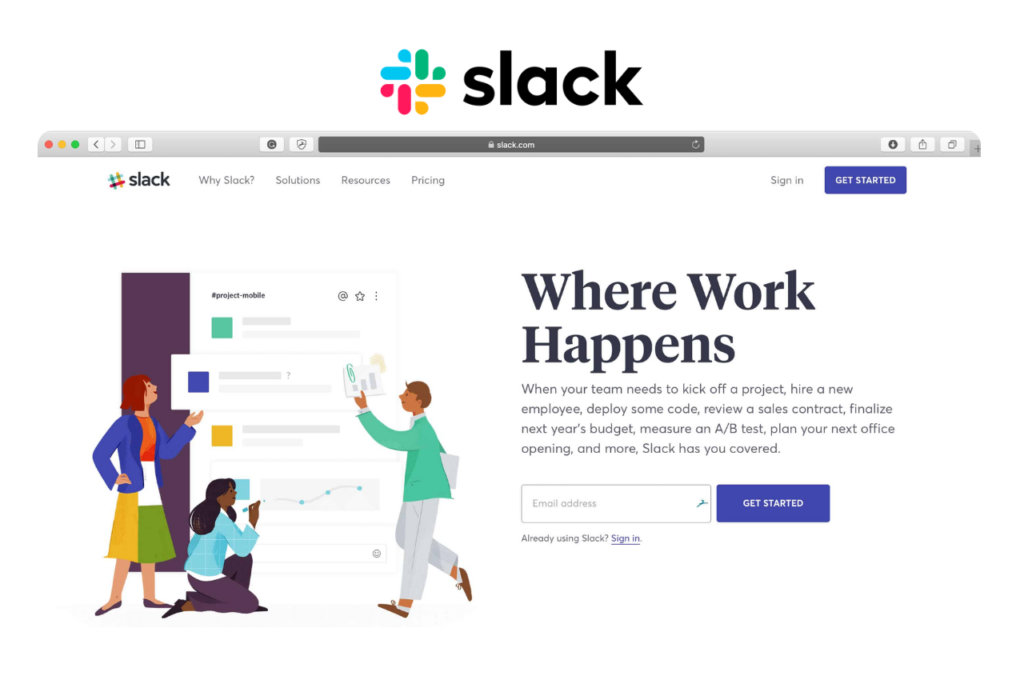
Slack is a popular messaging platform and communication tool primarily designed for instant messaging and file sharing among teams, particularly within software development. It is widely recognized for improving real-time communication and collaboration within software development teams.
Slack Pros
- Real-time communication and collaboration.
- Highly customizable and provides many options for integration.
- Scalability: Can be accessed through a number of devices and has an excellent mobile application.
- Easy to set up.
- Effective for remote developers with timely notifications and collaboration features.
- Helps organize teams within teams effectively using channels.
- A powerful, team-oriented messaging platform.
Slack Cons
- Cost: Advanced features or use by larger teams require a paid plan, which can be expensive.
- Notification Overload: Can be overwhelming with too many notifications, acting as an “interruption monster” if not managed with clear configuration.
Slack Pricing
Slack offers a free plan with limited features and integrations.
Paid plans include Pro (or Standard), Business+ (or Business), and Enterprise Grid, with pricing generally increasing per user per month for more advanced features.
For small to medium businesses, pricing starts around $7.25 per user/month, with advanced features unlocked at higher tiers like $12.50 per person/month or $15 per user/month.
Other Interesting Collaboration Tools
The following table outlines several other popular collaboration tools, each with its own strengths and pricing structure. GitKraken stands out for its intuitive Git management, offering a free tier with some limitations and a range of paid plans, starting at $4.95 per month. For visual project management, Trello is an excellent choice, known for its Kanban charts. Its free tier provides unlimited cards and up to 10 boards, while paid plans begin at $5 per month.
Asana is a robust option for general project and task management, offering a free tier for up to 10 teammates and pricing for its Starter tier at $10.99 per month. ClickUp positions itself as an all-in-one platform with a generous free plan that includes unlimited tasks and members, with paid options starting at $7 per month. Lastly, Confluence specializes in knowledge documentation, providing a free tier with 2 GB of storage and paid plans starting at $5.16 per month.
| Tool | Best for | Free tier info | Price |
| GitKraken | Intuitive Git management | Free 14-day trial of the Advanced plan Unlimited cloud Git integrations Only local repos and public remotes Slack and Help Center support Built-in GitHub Copilot (GitLens) | Pro Tier: $4.95 per month Advanced Tier: $12 per month Enterprise: $20 per month |
| Trello | Kanban charts for visual project management | Unlimited cards Up to 10 boards per Workspace Quickly capture to-dos from email, Slack, and Teams Unlimited Power-Ups per board Unlimited storage (10MB/file) 250 Workspace command runs per month Custom backgrounds & stickers Unlimited activity log Assignee and due dates iOS and Android mobile apps 2-factor authentication | Standard Tier: $5 per month Premium Tier: $10 per month Enterprise: $17.50 per month |
| Asana | Project management and team task | Collaborate with up to 10 teammates Unlimited tasks Unlimited projects Unlimited messages Activity logs Unlimited storage (up to 100 MB per file) List, board, and calendar views Basic search filters Status update Mobile apps for iOS and Android Time tracking with integrations Over 100 free integrations | Starter Tier: $10.99 per month Advanced Tier: $24.99 per month Enterprise: contact sales |
| ClickUp | All-in-one project management platform | 60MB Storage Unlimited Tasks Unlimited Free Plan Members Two-Factor Authentication Collaborative Docs Kanban Boards Sprint Management Calendar View Custom Field Manager Basic In-App Video Recording 24/7 Support | Standard Tier: $7 per month Premium Tier: $12 per month Enterprise: contact sales |
| Confluence | Knowledge documentation | Wiki Pages and Spaces to document your development Organize and connect work with databases Templates for Marketing, Product, Program Management, and more Up to 3 active whiteboards per user10 automation rule runs per month Support for apps and integrations Support from Atlassian Community Up to 2 GB file storage | Standard Tier: $5.16 per month Premium Tier: $9.73 per month Enterprise: contact sales |
Conclusion
While there are countless options available, the best collaboration tools for developers are those that integrate seamlessly into your existing processes, whether you prioritize robust version control, agile project management, or real-time code collaboration.
As you’ve seen, platforms like GitHub, GitLab, or Azure DevOps offer comprehensive, all-in-one solutions that cover the entire DevOps lifecycle. For teams already embedded in a specific ecosystem, tools like BitBucket and Jira provide powerful Atlassian integrations. If your team is focused on remote work and lightweight, real-time collaboration, Visual Studio Live Share and Codeanywhere are excellent choices. And for front-end developers, Codepen provides a perfect sandbox for creativity.
Ultimately, the best tool is the one that aligns with your team’s specific needs, project requirements, and company culture. By carefully evaluating the features, pricing, and use cases, you can select a tool that not only streamlines your work but also helps your team thrive.


